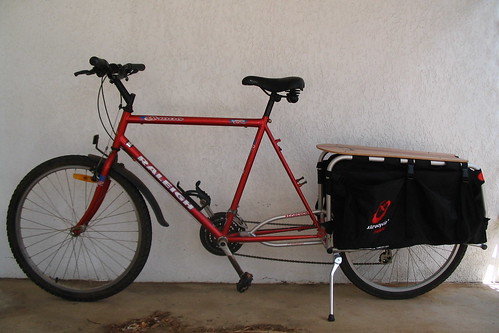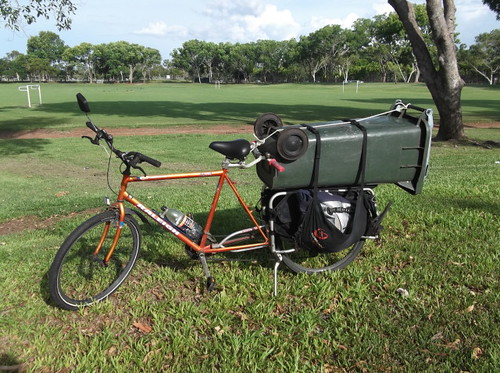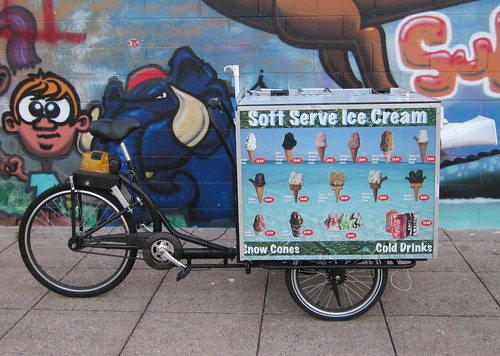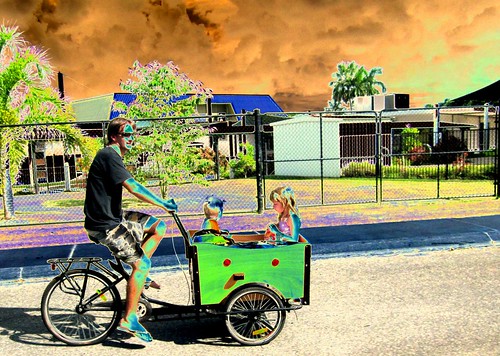RICKSHAW - TRISHAW - BECAK - UTILITY BIKES Thinking about solutions to the worlds transport, pollution and employment problems stories, images and various other information to promote understanding and acceptance of human powered transportation. Appropriate transport for the contemporary world
Wednesday, July 25, 2012
Friday, February 10, 2012
Cargo fleet
Oh I have neglected this site terribly! I am so sorry guys but I have ignored the criteria for my own blog. I've focused on Rickshaws and pedicabs and forgotten completely to talk about cargo bikes.
Well I don't actually have the time or feel inspired to do that right now but I thought I'd at least post a couple of photos of my two amazing cargo bikes, which I have come to depend upon for carting all kinds of stuff, while usually transporting my kids at the same time!
Firstly I'd like to introduce you to the Xtracycle.
This has been my primary mode of transport since 2008... I think...


She can carry a load!
THE CARGOBIKE (In Ice-cream bike mode)

Cargobike as she was when I purchased her

Cargobike in family transport mode
Well I don't actually have the time or feel inspired to do that right now but I thought I'd at least post a couple of photos of my two amazing cargo bikes, which I have come to depend upon for carting all kinds of stuff, while usually transporting my kids at the same time!
Firstly I'd like to introduce you to the Xtracycle.
This has been my primary mode of transport since 2008... I think...


She can carry a load!
THE CARGOBIKE (In Ice-cream bike mode)

Cargobike as she was when I purchased her

Cargobike in family transport mode
Labels:
bike,
cargobike,
cart,
ice cream,
ice-cream cart,
riding,
utility bike,
xtracycle
Subscribe to:
Comments (Atom)
A Guest Post from environmentalist and rickshaw advocate Sayed Saiful Alam from Dhaka, Bangladesh.


- Author:
Syed Saiful Alam
How inhuman is the business of pedaling a rickshaw? It might not be a profession most of you reading this article would like to have, but neither is it likely you would wish to spend hours a day standing in water, bent at the waist, transplanting rice. The measure of whether a profession is inhuman is not whether or not we are willing to engage in it, but rather what those working in it feel about it and what their alternatives are. Rickshaw pulling is a huge source of needed jobs; the pullers themselves clearly prefer it to begging or starving. Further, unlike many other professions, it is fairly well-paid, involves a good deal of independence, and gives the pullers a chance to choose their hours and to rest when they wish. It is thus far less inhuman than many other professions. What is inhuman is denying people the right to earn a living.How well can we manage without the rickshaw in Dhaka? It is important to remember that many trips taken are short. Does it make sense to wait 10-20 minutes for a bus in order to travel 3 kilometres? What if you have many destinations: say a woman taking her child to school, going to a shop, visiting a relative, going home, then going back to pick up her child? If she had to buy separate bus tickets for each trip segment, the expense would be exorbitant. No wonder 41% of trips to take children to school occur by rickshaw; it is a safe, convenient, and affordable form of door-to-door transport.
As for walking as an alternative, we are all for it: but first there needs to be a better environment for walking. The problems faced by those on foot in Dhaka are numerous: footpaths in bad condition, often occupied by parked cars, and used at times by motorbikes; lack of safe street crossings; bad smells due to the lack of public toilets; lack of safety at night; and the exposure to continual fumes and noise from the traffic on the streets. Rickshaws provide a fairly pleasant alternative to the dismal business of walking in Dhaka; it is unfair to the middle class to take away that option in the assumption that they should either buy a car or suffer on buses, which themselves involve a number of obstacles to comfortable travel and of course only operate on certain routes, causing problems for those traveling with children, carrying heavy items, and so on.
Speaking of the popularity of rickshaws, it is helpful to compare the percentage of trips that occur by rickshaw versus car. No measures have been taken to ban cars from narrow lanes, despite the obvious fact that cars create congestion in the lanes, blocking the easy movement of hundreds of people traveling by rickshaw. Far from it: the building code is insisting on the provision of ever more car parking, providing incentive for ever more cars, even on narrow streets. But how popular is the car versus the rickshaw?
According to the latest government figures, for overall trips in the Dhaka Metropolitan Area and Dhaka City Corporation, 4-5% are made by car versus 29-39% by rickshaw. While men make 32% of their trips by car, that figure is 47.4% for women. As mentioned, 41% of trips to school occur by rickshaw; only 4% are taken by car (yet cars already create hideous congestion around schools and during the times when children go to and from school). While car use is far higher among the wealthy (here defined as those earning over 50,000 taka per month), at 18% of trips, that figure is still dwarfed by rickshaw trips: 35% of trips taken by the wealthy are by rickshaw. That is, rickshaws account for twice the number of trips as cars even among the wealthier, and up to ten times as many trips overall. If it is so important to ban vehicles due to the congestion they create, why on earth is it the rickshaw that is being banned?
What after all is a rickshaw but a three-wheeled bicycle (imagine trying to cycle through Dhaka...no wonder people prefer rickshaws!). Given the related catastrophes of climate change, peak oil, obesity, and lack of physical activity, governments around the world are trying to get people out of their cars. It is the low-income cities of the world that are heading in the opposite direction, laying out the red carpet for cars while making life difficult and unsafe for pedestrians and cyclists. Why are policymakers in Dhaka insistent on making things worse for the city rather than better? If we really want to reduce traffic congestion, we must do what city after city around the world has been forced to do: actively work to reduce travel by car and increase travel by other means.
Years ago, an international transport expert referred to Dhaka’s modal share as “enviable”: few cars and many rickshaws. Rather than appreciate what we had and work to make things even better, we are instead working to increase traffic congestion, noise, fumes, and expense, and to make moving about the city more difficult for the non-car-owning majority.
It is also interesting to note that the latest rickshaw bans occurred after government decisions to limit car use through a variety of measures. To the best of our knowledge, none of those measures have been implemented to date, while other measures to encourage car use continue. What was done instead, despite significant media attention over the last few years to the problem of private cars, was to ban rickshaws from various streets. Clearly the decision was based on prejudice, not any technical understanding of the situation. It allows the government to say that it is doing something to improve traffic, while only making matters worse, because politically it is difficult to put into places measures to reduce the vehicle preferred by a tiny portion of the most wealthy and powerful.
But it is wrong to believe that only rickshaw pullers are upset by the bans. Dhaka residents have long suffered for the various bans that have been put into place over the years: witness the long lines of people attempting to go to and from New Market by rickshaw, or the anger of women in focus groups discussing the rickshaw bans on Mirpur Road. Of course people want safe, convenient, comfortable transport. People also vote. It is not wise to anger the masses through such wrong-minded decisions.
It is time to raise our voices in support of smart traffic planning: to ensure that all people, not just those with a car, can move about safely and conveniently; that non-polluting modes are given priority; and that international experience in addressing traffic congestion is put to good use here. It is time to say no to further rickshaw bans, to overturn the recent ones, and to work together to make Dhaka a city in which people can move about safely, comfortably, and conveniently on foot, on 2- and 3-wheeled bicycles (rickshaws), and on public transport. We would all benefit from the improved air quality, safety, and convenience.
Syed Saiful Alam
Environmental Activist